Before starting binary options trading, beginners have many questions, one of which is - which time frame is better for binary options? And to answer this question, it is necessary to consider all existing time frames, as well as what types of trading they are suitable for. It is also worth noting that choosing the best timeframe is not the most difficult process, and with experience this will happen automatically.
What is a binary options timeframe?
Every trader who has studied the capabilities of various trading platforms knows that each of them has a panel with all timeframes existing on this platform. A timeframe is a time interval that allows you to look at price changes over any time period. And to put it even more simply, changing the timeframe makes it possible to look at any hour, day, week or month in more detail (as if under a “microscope”).
Accordingly, if a 5-minute binary option timeframe is selected, then the chart will plot candles or bars for every five minutes of the current time. Exactly the same construction occurs for other timeframes:
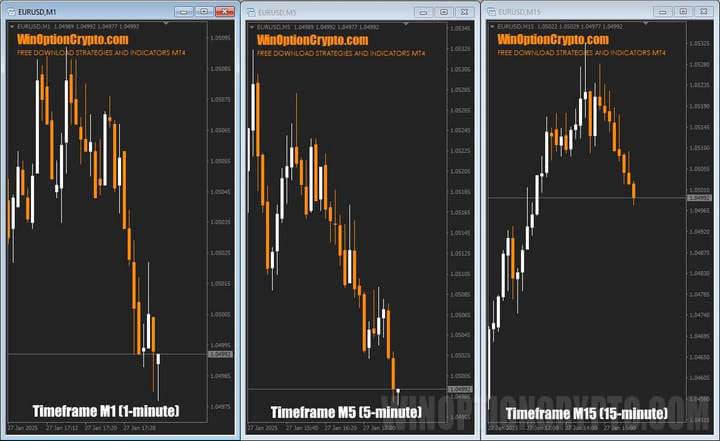
Also, some novice traders may confuse the concept of timeframe with expiration time of binary options , but it is important to understand that these are completely different time concepts.
Types of time frames in binary options
Timeframes, as has already become clear, come in different types, and the most common are periods from M1 (minute timeframe) to 1M (monthly timeframe).
But these are not all time frames that can be used for trading digital contracts, and using the TradingView trading platform as an example, you can see that there are other types of time periods:
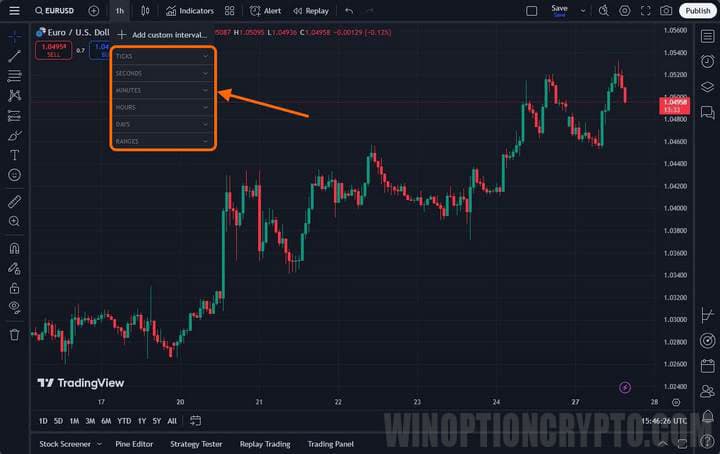
If minutes, hours and days are available in any trading terminals, including MetaTrader 4 , then seconds, and even more so range charts, are not available everywhere.
The second timeframe is most often divided into 1, 5, 15 and 30 seconds, which allows you to see very rapid changes in price, and range charts are built on time, and on a given price range, and for example, if the second chart plots a new candle every second, then the range chart builds a new candle if the asset has passed the specified number of points. For example, if the EUR/USD currency pair has a range of 10 points, then a new candle or bar will be built only when the pair rises or falls by 10 points. The Range graph itself (10) looks like this:
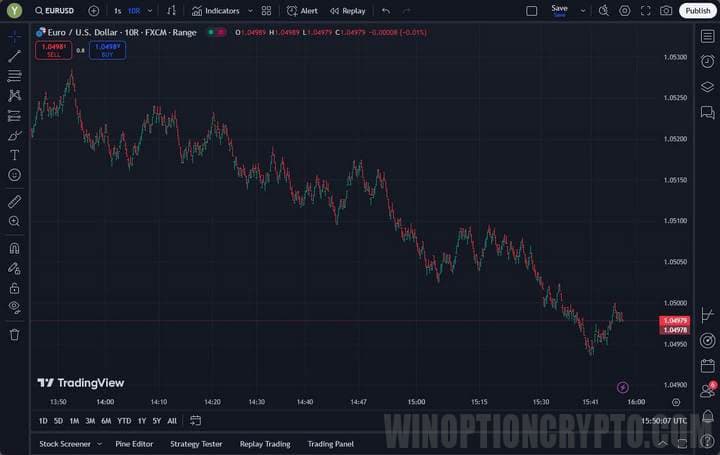
Also, if there is a need to analyze second charts, then most binary options brokers provide this opportunity, including the Pocket Option broker :
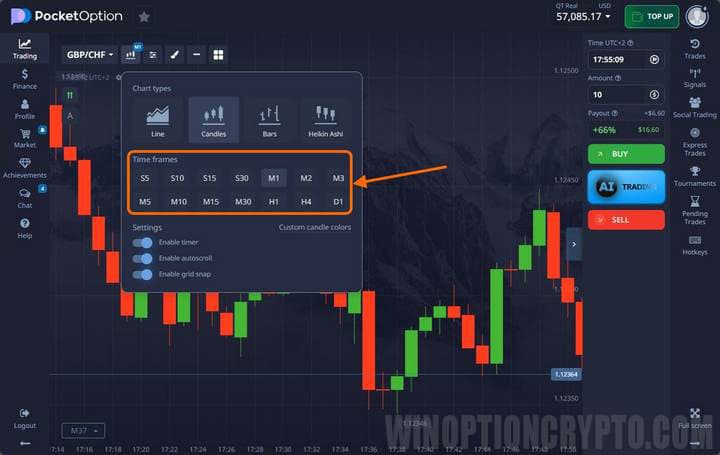
Which time frame is better for binary options
To understand which timeframe is suitable for trading, it is worth deciding on your trading style. The main styles are:
- Scalping (turbo options).
- Intraday trading.
- Medium and long term trading.
It is worth noting right away that it is better for beginners not to consider scalping, since in addition to high risks due to the large number of transactions, this type of trading requires experience and making very quick decisions, as well as high stress resistance.
Long-term trading also requires some knowledge and experience, but unlike scalping it carries much lower risks.
Once the choice of trading style has been made, it is worth understanding the trading approach, which can be implemented using:
Trading on a pure chart can also be divided into candlestick analysis , trading using support and resistance levels , graphical analysis or Price Action .
Each of these approaches has its pros and cons, but beginners most often prefer strategies and indicators, since such trading is the simplest and does not require much knowledge. The remaining approaches, although they require studying patterns and rules, are more effective and universal, as they are suitable for any markets and time frames.
Best Time Frame for Turbo Options
If you have chosen to trade turbo options, then the best time frame will be M1 and M5, and it is best to use these time frames in conjunction. To put it simply, you can carry out analysis on the M5 timeframe, and look for an entry point on M1. Expiration for such trading does not exceed 5 minutes, and most often it is 1-3 minutes.
There are traders who use the M1 timeframe for analysis and do not look at other time periods to make transactions. This approach requires experience in trading, as you need to understand your trading instrument and know exactly when you can and cannot make a trade.
A simple example of trading turbo options is analysis using the MACD indicator . On the minute chart below you can see how, at the moment the indicator crosses the zero level (or crosses the Moving Averages on the indicator), it gives a signal to buy a Call option with expiration in 1 minute:
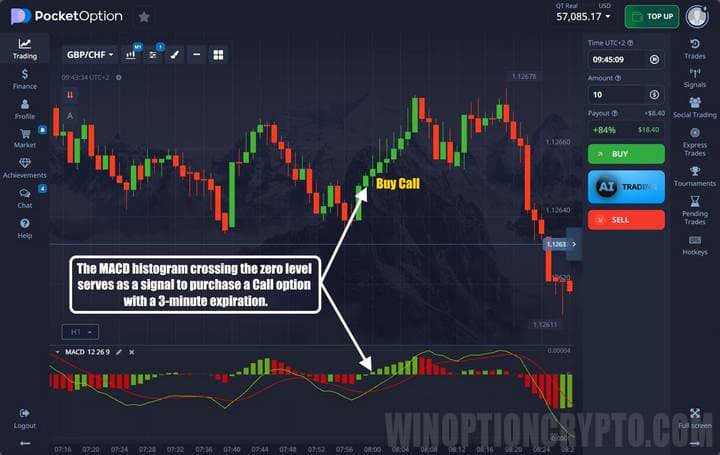
Also note that a longer expiration could have been used.
Another example of trading on small timeframes, but using Price Action:
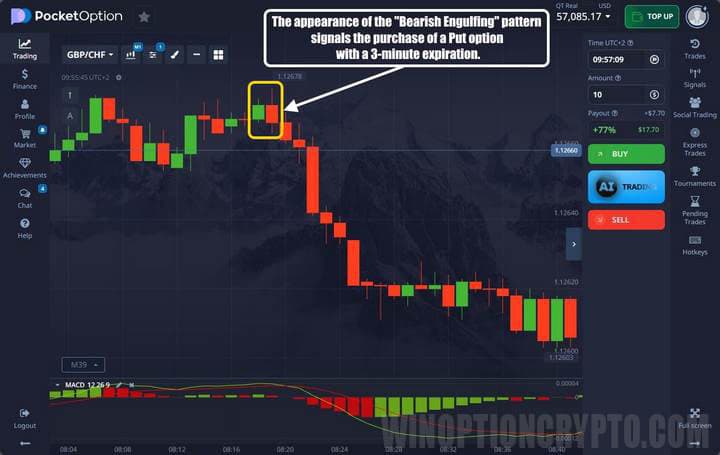
It is worth noting that the examples given above are just some of the many ways to trade binary options and before using them you should definitely try everything on a demo account .
Best Time Frame for Long Term Options
The best time frames for intraday trading are M5 and M15, and transactions are concluded for at least 1 hour. Medium and long-term trading is used with timeframes from H1 and higher, and expiration can range from several days to several months.
For medium/long-term trading or intraday trading, you can use exactly the same methods and approaches that were shown above in the examples of trading turbo options, since, in fact, only the timeframe changes, but the market itself remains the same, and all indicators or the patterns work the same everywhere. The only thing that has a greater impact on large time frames are fundamental factors, which can be determined by conducting fundamental analysis .
A simple example of trading on the daily timeframe using levels that were built from the beginning of places of strong price movement:
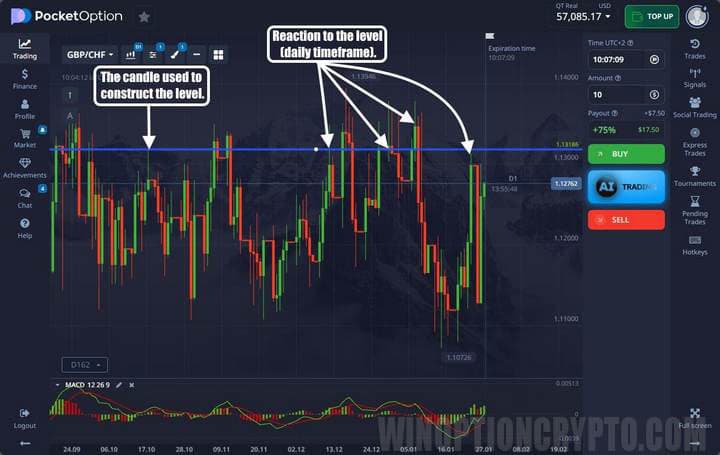
As you can see, even on the daily binary options timeframe, everything works exactly the same as on the minute one.
Recommendations for beginners in choosing a time frame for binary options
When choosing the best timeframe for binary options, you should pay attention to the following points:
- Before choosing a time frame, you should determine your trading style (scalping, intraday trading or long-term trading).
- Choose the type of analysis for trading, since technical analysis and its subsections allow you to trade on any time frames, while fundamental analysis is intended for time frames from H1 and higher.
- Determine your risks, since the higher the risk a trader can afford, the greater the number of transactions that can be made, and the required timeframe depends on this.
- At the initial stage, beginners should not use second or exotic timeframes for analysis (range charts or candles built by volume).
Conclusion
You don't have to be a professional trader to determine which timeframe is best for binary options. But you should not take the above examples as ready-made trading tactics and strategies or as a recommendation to trade in this particular way, since binary options trading is more than just copying other people’s approaches and techniques. For successful trading, it is imperative to develop your own trading approach and gain experience, since without experience it is impossible to start receiving a stable income in the financial markets.
Also, you should test all your ideas on a demo account, and only after that switch to a real account. And when trading on a real account, you should definitely adhere to the rules of money management and risk management .



To leave a comment, you must register or log in to your account.